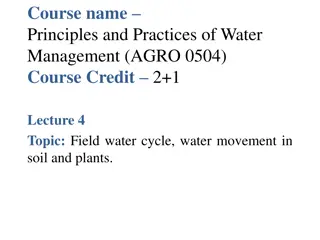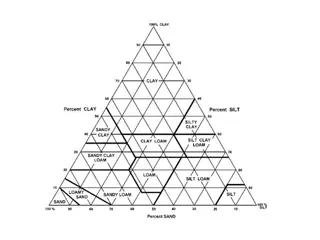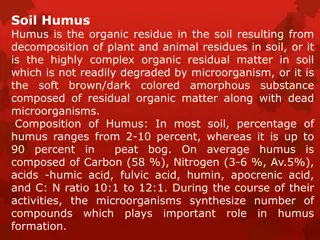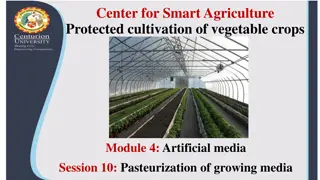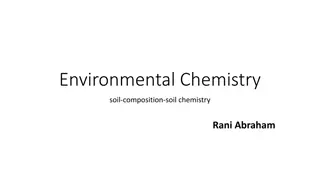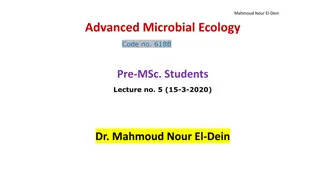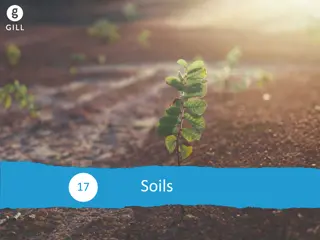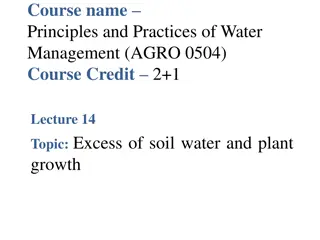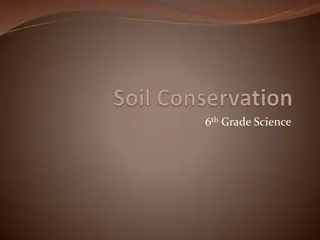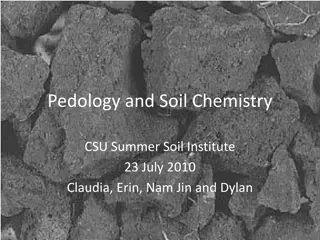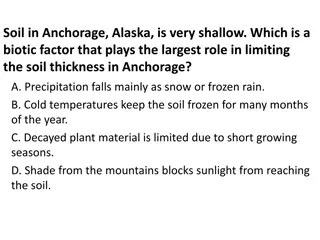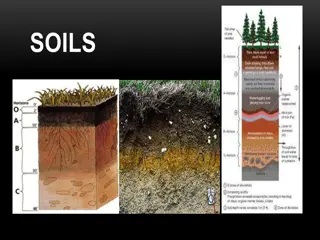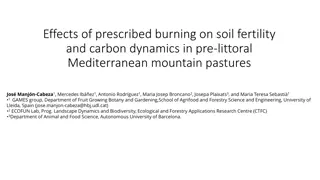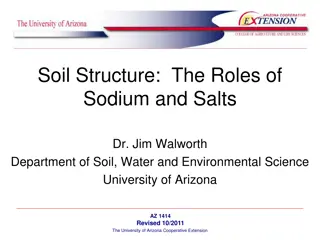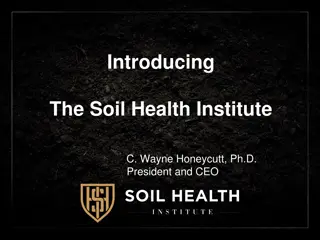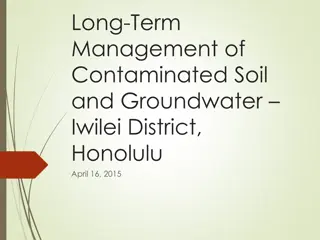Environmental Physicochemical Analysis for Water and Soil
This chapter delves into the importance of analyzing water, wastewater, soil, and air for environmental protection. It covers topics such as water quality types, impurity exploration, measurement units, and proper conversions. The content highlights the critical need to quantify contaminants in different environmental compartments to safeguard the environment and its inhabitants. Sustainable Development Goals related to water, sanitation, and hygiene are also discussed.
Download Presentation

Please find below an Image/Link to download the presentation.
The content on the website is provided AS IS for your information and personal use only. It may not be sold, licensed, or shared on other websites without obtaining consent from the author. Download presentation by click this link. If you encounter any issues during the download, it is possible that the publisher has removed the file from their server.
E N D
Presentation Transcript
Environmental physicochemical analysis of water, wastewater, soil and air Learning objectives: Upon completion of this chapter, the student should have knowledge of the following: Describe water qualitytypes Explore water impurity and the need for quantification Able to relate different units of measurement for water analysis Explain proper units and conversions in water, soil and air measurement.
1. Introduction Substances distributed among the environmental compartments: water (hydrosphere), soil, rock (lithosphere), and air (atmosphere), as well as among the organisms living on them (biosphere). Only if we know the type and quantity of these contaminants can we protect the environment and its inhabitants. introduced into the environment are
Water Currently, ~ 900 million people suffer from drinking water shortages, circa 2.6 billion people live without safe sanitation and approximately 2.5 billion people have no wastewater treatment. Five million people die every year as a result of deficient hygienic conditions, most of them children About 1.5 million children die each year due to water-borne diseases (UN 2010) These issues particularly affect emerging and developingcountries As reported by Ethiopian demographics profile 2018 Improved: Urban 93.1% , rural 48.6% and total 57.3% of population Unimproved: Urban 6.9%; Rural 51.4% and total 42.7% of population Drinking water source
Water (Contd) As its physical state changes, water passes through all spheres. It is the most frequently analyzed environmental compartment and is also the easiest, because unlike air or soil it already exists in the liquid phase. If drinking water samples are to be analyzed, sample preparation is usually not necessary; however, it is usually unavoidable in the case of wastewater samples.
Water (Contd) Parameter (Surfacewater) BOD5 Chloride Chlorine, Residual Chromium Conductivity Dissolved oxygen Fluoride Nitrate Limit < 5 mg/l O2 250 mg/l Cl 5 g/l as HOCl 50 g/l Cr 1000 S/Cm (@ 20 C) minimum 6 mg/l O2 1.0 mg/l F 50 mg/l NO3
Sustainable Development Goals: Targets related to WASH 3.3 by 2030 end the epidemics of AIDS, tuberculosis, malaria, and neglected tropical diseases and combat hepatitis, water-borne diseases, and other communicable diseases. 3.9 by 2030 substantially reduce the number of deaths and illnesses from hazardous chemicals and air, water, and soil pollution andcontamination. 6.1 by 2030 achieve universal and equitable access to safe and affordable drinking water for all. 6.2 by 2030 achieve access to adequate and equitable sanitation and hygiene for all, and end open defecation, paying special attention to the needs of women and girls and those in vulnerablesituations. 6.a by 2030 expand international cooperation and capacity-building support to developing countries in water and sanitation related activities and programmes, including water harvesting, desalination, water efficiency, wastewater treatment, recycling and reuse technologies. 6.b support and strengthen the participation of local communities for improving water and sanitationmanagement.
Challenges Financing and budgeting process Insufficient financing Generating revenue through tariffs insufficient funding for operation and maintenance Watergovernance Deficient institutional and administrative structures, lack of political will, accountability and lack of stakeholder engagement Water safety Ensuring safe drinking water in the home is difficult
Soil The hydrosphere, atmosphere, lithosphere, exist side by side. soil is a multiphase system in which the and biosphere It serves as a source of water and nutrients for plants, is a habitat for a large number of organisms, and is an important carbon sink. Harmful soil pollutants can easily enter the human body through plants and animals. The constituents of soil are very difficult to access and difficult to mobilize. Sample involves extraction and digestion procedures. preparation usually
Soil (Contd) (mg/kg dry weight) Parameter The soil forms the key basis of life for plants, 500 20 40 0.5 1 Chromium, total Chromium (VI) Lead Cadmium Mercury animals, and humans. Harmful substances contained in it come mainly from weathering, Nickel 30 cultivation, or the air.
Air The atmosphere is an important thermal buffer against space, and protects the earth from cosmic radiation. It is the place where clouds are formed and water is present there in all its physical states. Thus it is a heterogeneous mixture of finely dispersed, solid or liquid particles in a gas (air). Its constituents are characterized by extreme mobility, enter our organism easily through breathing, and influence the climate and weather. Filter methods, and aerosol and gas collectors bring the constituents of air into the aqueous phase, which is preferable for chemical analysis.
Air (Contd) Parameter Standard [ g/m3] Average time On average about 300,000 m3 air pass person s respiratory system in the course of a lifetime. SO2 500 125 50 200 40 100000 60000 10000 10 minutes 24 hrs 1 year 1 hr 1 year 15 minutes 30 minutes 8 hrs through a NO2 In this way, impurities in the atmosphere directly enter the lungs. CO 120 50 150 15 65 0.5 8 hrs 1 year 24 hrs 1 year 24 hrs 1 year Especially dangerous are the aerosols particles with diameters of less than 10 m also know as particulate matter. PM10 that contain PM2.5 Lead
1.1. General Facts Currently there are a growing desire to restore and protect the env t from degrading effects of all forms of pollution: air,water,soil, and noise Three major questions usually arise when a particular type of pollution has been identified: 1. How serious is the pollution? Is there standard procedure for sampling water, air and soil? 3. Is possible to quantify pollutants? & This course is basically focuses on demonstration of laboratory equipment and apparatus, sampling, preservation, analysis and interpretation of the results. 2.
1.2. DEFINING ENVIRONMENTAL WATERQUALITY WQ means d/t things to d/t people, depending on their goals for the water. The env tal health student express high-quality water as water in a pristine env nt free from diseases causing pathogens and chemical sb/ces. 1.2.1 W A TER-USE CLASSIFICA TIONS AND W A TER QUALITYSTANDARDS In human history, rivers, lakes, springs, & wells from which one can directly drink could readily meet almost all needs for high quality water.
Contd But now the water that is used for drinking water supplies, irrigation, and industry, , needs treatment to become acceptable. High-quality water is not pure; it just contains amounts of impurities too small to be harmful to its intended uses. Many impurities in water are beneficial: carbonate (CO3-2) and bicarbonate (HCO3-) hardness and alkalinity dissolved CO2, and O2 Outside a chemical laboratory, extremely pure water generally is not desirable What is water impurity?
Contd It is any sub/ce in water that is not derived from a water molecule only: harmful, beneficial, or neutral A water pollutant or contaminant is any substance in water that is to be harmful to the water s intended uses. There are three d/t types of water quality standards set by U.S. state & federal regulations but there is only effluent & drinking water regulations in Ethiopia: 1. Surface and groundwater standards 2. Effluent standards 3. Drinking water standards
1.3. SOURCES OF WATERIMPURITIES A. Natural sources B. Human caused Impurities can be divided into three classes: regulated impurities (pollutants) considered harmful or aesthetically objectionable unregulated impurities not considered harmful, and unregulated impurities not yet evaluated for their potential health risks.
1.4. WHAT IMPURITIES AREPRESENT? The chemical content of a water sample is found by qualitative chemical analysis Qualitative analysis identifies the chemical species present WORKING WITH CONCENTRATIONS Unfortunately, there is not one all-purpose method for expressing concentration The best choice of concentration units depends in part on the medium (liquid, solid, or gas), and in part on the purpose of the measurement
WORKING WITH CONCENTRATIONS (Contd) In water samples, impurity concentrations are typically reported as: milligrams (mg) micrograms ( g), or nanograms (ng) of impurity per liter (L) of water sample. 1 mg/L = 10-3 g/L = 1 part per million(ppm) 1 g/L=10-6 g/L = 1 part per billion(ppb) 1 ng/L = 10-9 g/L = 1 part per trillion(ppt)
WORKING WITH CONCENTRATIONS (Contd) In soil samples, impurity concentrations are typically reported as milligrams, micrograms, or nanograms of impurity per kilogram of soil sample 1 mg/kg = 10-3g/kg = 1 part per million(ppm) 1 g/kg = 10-6g/kg = 1 part per billion(ppb) 1 ng/kg = 10-9g/kg = 1 part per trillion(ppt) In gas samples (normally air samples), concentrations cannot be expressed as simply as in water or soils, because gas volumes and densities are strongly dependent on temperature and pressure.
Unit of measurement for airanalysis Concentrations of air pollutants are commonly expressed as the mass of pollutant per unit volume of air mixture, as mg/m3, g/m3, ng /m3 1ppm= 0.0001 % by volume. The relationship between ppm and mg/m3depends on the gas density, which in turn depends on: Temperature Pressure Molecular weight of the pollutant
Unit of measurement for air analysis(contd) The ff expression can be used to convert the units b/n ppm and mg/m3 at any temp. orpressure. mg/m3 = 273 x ppm x molecular wt. x pressure/22.4 xtemperature Example 1: Federal standard limits hourly carbon dioxide levelsto 0.8 ppm. Express this concentration in terms of g/m3 at 270C and 1 atmospheric pressure. Solution Molecular weight of carbondixide = 12+16 +16 = 44; Temperature = 27 +273 = 300K mg/m3 = 273 x 0.8 ppm x 44 x 1 atm./22.4x 300K; = 1.43 =>1430 g/m3











